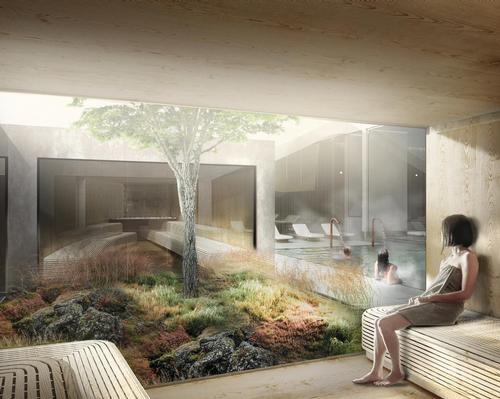01 Jun 2020
Plans revealed for luxury spa resort at ‘Heart chakra of the earth’ in Hungary
BY Megan Whitby

Architecture practice Johannes Torpe Studios has unveiled the first glimpses of the Buda Resort; a luxury spa resort located in the Visegrad Hills of Hungary and inspired by the spiritual symbolism of its setting.
Situated 50km north of Budapest in a hilly landscape surrounded by forests and the Danube River; the vision for the 210-room resort is to offer a holistic retreat which fosters a greater sense of unity between humans and the therapeutic qualities of nature.
Originally an unfinished and derelict Hilton hotel built on an old stone quarry and untouched since the early 2000s, the location is set to be transformed into a luxury spa and wellness resort concept.
According to Johannes Torpe Studios, the project has been delivered to the developer and is ongoing internally.
An overview of the spa facilities includes a 1,200sq m family spa area on the first floor, a 4,000sq m partially underground adult-only spa building, aromatherapy and Finnish saunas and steam baths, along with saltwater pools, fire and ice plunge pools, and light and sound sensory baths.
“In uncertain times like these, it is now more important than ever to present projects that inspire people to dream for the times to come to create a destination that provides guests with the opportunity to renew their perspectives and engage in mindfulness," explained Torpe.
“This project offers a completely unique experience which sets aside the obvious functions of a classic spa resort. The location speaks for itself in its natural beauty and is a place to be revered during all four seasons.”
On the spa’s lower levels, guests will discover revitalising spa areas that reflect the concept of spatial contraction and expansion through an array of facilities which provide guests with areas both for privacy and social interaction.
The upper spa area will feature treatment rooms for individual consultations designed with light and softly shaped settings, while a collection of dark and quiet steam chambers on the spa’s lower level will offer an intimate setting for small groups.
From the underground steam area, guests will be able to either move further into ‘the cave’; a contemporary Turkish bath with secluded chambers alongside the pool, or access the newly added adults-only spa building for a calming atmosphere with indoor and outdoor thermal pools, saunas, and private Jacuzzis.
Facilities will also feature six outdoor areas including a range of yoga platforms, seven outdoor pools – two of which are thermic – and a green rooftop plaza.
The design concept draws inspiration from its location, set in the popular tourist destination called Dobogó-kő – a Hungarian phrase meaning “beating stone” which refers to the location’s nickname, ‘the heart chakra of the earth’.
The location was branded with this name because it is apparently spiritually significant according to the Gaia hypothesis, a belief which upholds that the atmosphere and life on Earth behave dynamically as a single integrated physiological system consisting of a network of ley lines.
Places where ley lines intersect are claimed to hold high concentrations of the planet’s electrical charge signalling locations of sacred places, such as Stonehenge and the Egyptian Pyramids. The highest concentration of ley line intersections occurs at Dobogó-kő, which has consequently been interpreted as the ‘heart chakra of the planet’.
The Buda Resort is being designed by Johannes Torpe Studios to inspire guests to feel uplifted and rejuvenated by the surrounding sacred energy of nature, and to help them create and restore inner balance.
Based on the idea of a blossoming lotus flower, which is the universal symbol for the heart chakra – as well as a subtly reference to motifs found in traditional Hungarian craftsmanship – the building is being designed to unfold and open up like a flower from the heart of the building, to its extremities.
In addition to the spa, the hotel concept will feature a grand lobby area, two restaurants, café and deli, indoor and outdoor cocktail lounges, ballroom, and ten conference rooms with private gardens and outdoor areas.
Close Window